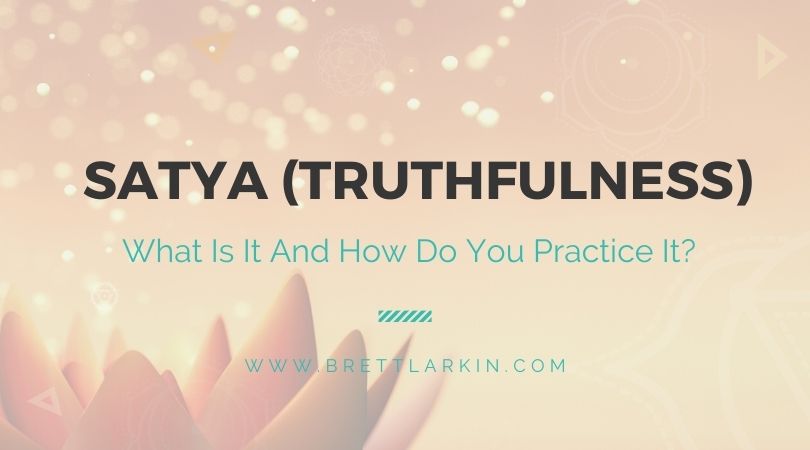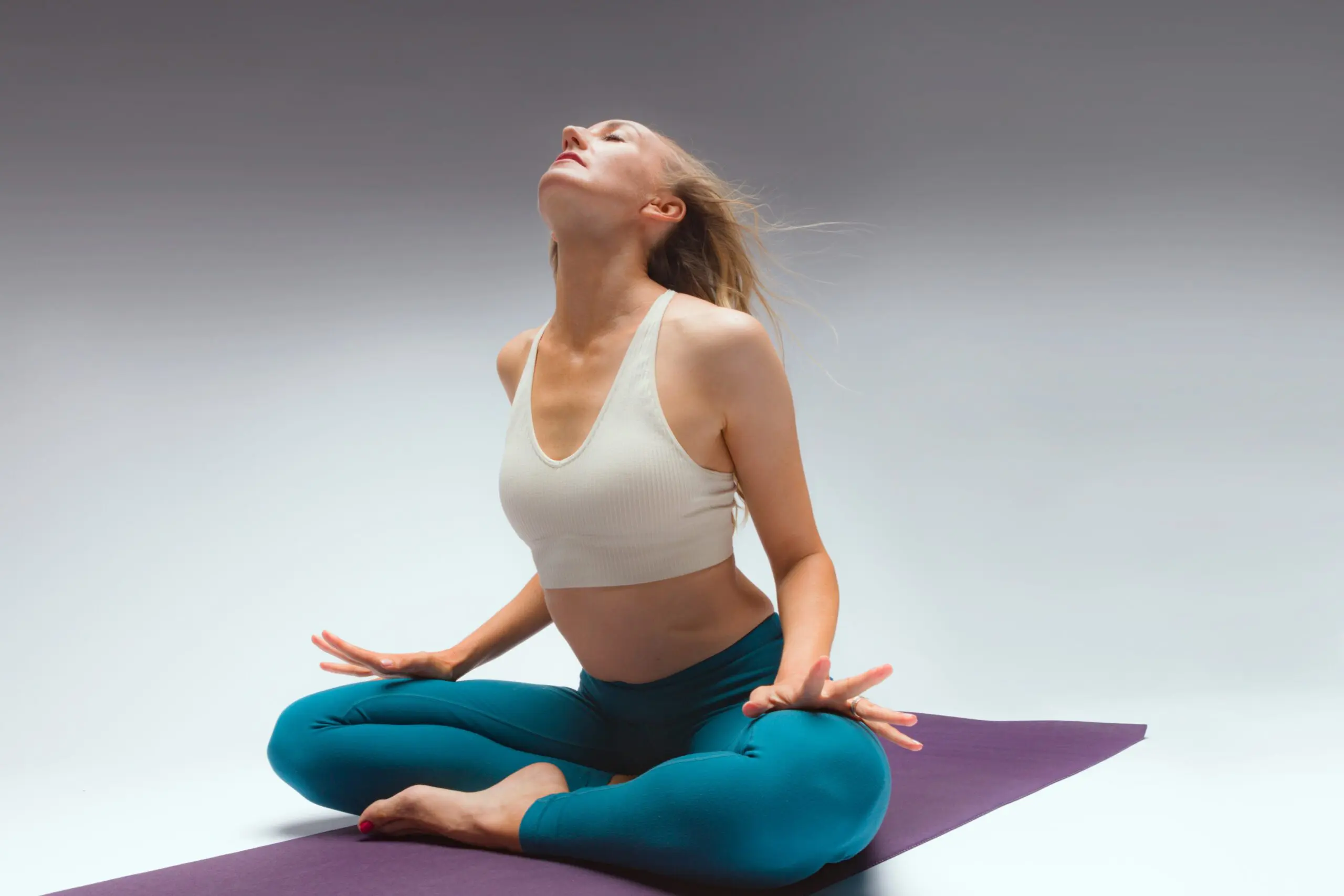
Do you consider yourself an honest person?
I did too.
As a yoga teacher and lifelong student I aim to practice pure speech in my daily life as well as teach it in my yoga classes.
However, there are times you might catch yourself telling completely unnecessary lies to those around you — even good friends and family. Hey, it happens to everyone. (Can’t just be me, right??)
Have you ever told someone you wouldn’t be able to meet up that night because ‘something came up with work,’ when truthfully, you were just tired and in the mood to be alone and curl up on the couch? A little lie like this can fly out before you even realize it’s a lie!
Even if there’s no need for this distortion of reality, we still do it for one reason or another.
When you recognize these little lies in your life, it might bring up questions like:
- Are we always aware of when or why we are lying?
- How might our lives change if we could actively choose our words with honesty and truthfulness?
- How does it feel to fully embody the truth and can it improve our well being?
If any of those questions resonate with you or if you’re just interested in learning more about truthfulness, then you’re in luck because that’s exactly what we’re going to talk about here!
What Does Satya Mean? Truthfulness
Satya (Sanskrit: सत्य) roughly translates from Sanskrit to truthfulness or truth and is the second yama of the five yamas of yoga. In practice though, we can apply satya to every aspect of our lives and it means so much more than simply telling the truth.
When we look at defining words from this ancient language of India, something we must understand is the feeling of the word, how it vibrates along the spine and how that vibration itself takes on much more than a literal meaning.
Where Is the Word Satya Derived From?
Satya is a Sanskrit word derived from ‘sat’ meaning ‘true essence’ or simply ‘being’ and ‘ya’ meaning to hold up or sustain. Combined together Satya implies, ‘that which holds up and sustains truth.’
‘Sat’ is a common prefix for many Sanskrit words such as, ‘satsang,’ (gathering together for the truth or being with the truth) and ‘sattva’, one of the three gunas, meaning purity. In this sense, the word Satya can mean, ‘that which is beyond limitations’, ‘unchangeable perception’ and ‘pure’.
Satya in Yoga: The Second Yama
In the Yoga Sutras, (Chapter 2 Verse 30,) Patanjali introduces the teachings of satya as the second of the 5 yamas – the 5 restraints or behaviours laid out in the first limb of yoga. The other 4 Yamas are ahimsa, non violence; asteya, non stealing; brahmacharya, sexual continence; and aparigraha, non attachment.
If we look at the five yamas like building blocks, each Yama rests upon the foundation of the previous one. With this understanding and knowing that satya follows ahimsa (the first and most important yama), we have to remember that we can’t fully practice the truth without first understanding the concept of non violence. This means in practicing Satya, we must aim to cause the least amount of harm possible while telling the truth.
Since Patanjali presents satya as a yama, we can understand this as an awareness or a restraint; we need to take our time and become more conscious of everything we say, our intention, and how it might affect others. With this interpretation, practicing satya doesn’t mean blindly telling the truth at all times — it’s more about considering our words and using the power of speech to express truth in alignment with ahimsa.
What Is Satya in Jainism?
Satya isn’t just in the Yoga Sutras though.
For example, Buddhism accounts Right Speech as one it’s 5 precepts and Jainism (the ancient Indian teaching path of spirituality,) teaches us that right knowledge, right faith and right conduct are the three essentials for attaining complete liberation. Again we see Satya as one of the five main conducts in order to attain this blissful state.
Jainism teaches us that one should refrain from falsehood and only speak truthfully, wholesomely and with compassion. If speaking the truth will cause pain or harm to yourself or others, maybe it’s best not to say anything at all and practice the virtue of silence.
Why Practice Satya On and Off the Mat
We have all caught ourselves in the middle of a yoga class, when the teacher guides us into a certain pose that we may not be the biggest fan of … Utkatasana anyone?!

Straight away, the vrittis or fluctuations of the mind can kick in: ‘What is this pose useful for anyway?’ ‘Why can’t I do this?’ ‘I don’t really want to do this pose anyway.” etc. And it’s as easy as that — our inner dialogue and ego falls to a place of limitation and judgement.
It’s this exact attachment to the vrittis that we want to move away from with our yoga practice. At the very root of yoga philosophy is the aim of coming back again and again to a place of self awareness and truth. When we apply satya to ourselves while practicing asana we can remember that we are simply the observer and can then assess ourselves honestly and without expectation.
Likewise in everyday life, practicing satya can be challenging if we can’t pause, observe our thought process, and give ourselves a bit of space to choose our words carefully. Most of us probably know the concept that honesty is the foundation for every healthy relationship, but defining what that actually looks like and how to follow through with it can be a totally different challenge.
As a start, simply observing the motive (and being honest about that motive!) behind our actions can help bring more honesty into our daily lives. Once you can recognize the motive, you can start to honestly compare whether or not the outcome is matching up with the motive.
How Do You Feel When Somebody Is Not Being Honest?
Finding out you have been lied to hurts, right? It causes suffering to everyone involved.
Even if the liar means to “protect” the other person from the truth, it can still hurt. The motive might be genuine, but even so — how damaging these lies can be!
When someone isn’t honest with you, it just doesn’t feel good. It can make you feel small and out of the loop. Worst of all, it destroys trust which can take a long time to build in the first place and takes even longer to build back.
Benefits of Practicing Satya
There are so many benefits of practicing satya or truth in our lives. These are a few big examples.
- Healthier Relationships: If we’re looking to build deeper, more meaningful and longer lasting relationships, practicing satya can help us do that. When we use satya, we naturally communicate from a place of love and understanding, which will increase our energetic vibration and attract other like-minded souls toward us and deepen the connections we already have.
- Clear Conscience: If you have a guilty conscience, then share things honestly and from a place of love, it can feel like a weight has been lifted from our shoulders — both literally and emotionally. When our minds are clear, our mental health improves, we have more energy, positivity, we sleep better, and feel an increase in motivation. (OK, I don’t know if this is scientifically proven, but it sure feels like it!)
- Trust in Yourself: After some time of practicing speaking the truth, we can fully embody what it means to trust ourselves. We are in such harmony with our truth that when it becomes time to make a big decision, we trust our inner guide 100%.
- Inspiring Others: If you’ve ever spent time with a person speaking from pure satya, you’ll understand how listening to their words can both comfort and inspire us. Their extensive self-knowledge and true character inspires others to also act from their own place of virtue and integrity.
How Can I Practice Satya? 6 Ways To Practice Satya In All Parts of Your Life

1. Practice Satya On the Mat
How can I practice Satya on the mat?
Come back to the question, ‘Why do I do asana practice at all?’ Is it to improve flexibility? Peace of mind? Be part of a community? Whatever your why is, practice with a pure intention and accept yourself exactly as you are in that moment.
Less judging. Instead of, ‘I’m not flexible enough, I’ll never be able to do it’ we can say, ‘This pose doesn’t come naturally to me, however I’m grateful to my body for doing its best.’
This helps us face our strengths and weaknesses on the yoga mat and practice all asanas (not just our favorites!) with equal curiosity and kindness, which will naturally begin to translate into daily life.
Don’t ignore the truths of your body. One of the worst ways to disrespect ourselves is to ignore our body’s wisdom. Feeling tired? Come back to your breath and take a child’s pose instead of a tough Vinyasa yoga flow. Take care of your own wellness first. Pushing beyond our boundaries during a physical practice is a sure fire way to injure ourselves.
Sitting in meditation, chanting Asato Maa mantra from the Upanishads is believed to lead us towards the truth;
Om Asato Maa Sad-Gamaya – Lead me from the unreal to the real.
Tamaso Maa Jyotir-Gamaya – From darkness (ignorance) to light (comprehension.)
Mrtyor-Maa Amrtam Gamaya – From death to immortality.
2. Practice Truthfulness at Home
If you’re asking, ‘How can I practice truthfulness in my actions at home?’ you’re not alone! The good news: there are many ways you can start.
For one, communicate clearly (and kindly) to loved ones. Instead of blindly voicing your thoughts by saying something like, ‘this house is a mess!,’ we can say ‘this house is not looking the way I would like it to, can we arrange a time to tidy it together?
Remember satya in the Yoga Sutras is a restraint — check in before you speak. Is it from a place of kindness or is the truth going to cause harm? If the truth is going to cause harm, is there a way you can say it that is more constructive and helpful rather than harmful?
3. Be Your True Self
The stories we tell ourselves have the power to grow roots in our minds and grow into external actions and real thoughts. It’s important to speak to ourselves with more care to increase our wellbeing.
Do you feel at home within yourself? In alignment with your own truth? (And be honest about this!)
If not, maybe it’s time to start learning what your real truth is — then you can work on living it. Practicing non-attachment to our thoughts can help us recognize our true nature, ‘satchidananda,’ (pure bliss.)
4. Speak Only Truth (With Compassion)
Speaking with truthfulness and compassion is the full practice of satya. According to the Sufi tradition, we should ask yourself three questions before voicing our truth:
- Is it true?
- Is it necessary?
- Is it kind?
5. Have Honest and Communicative Relationships
Honesty and communication can relate to every part of a relationship. One example is setting boundaries.
If you’ve ever been to therapy, you’ve probably heard people talk about setting boundaries in relationships. If you haven’t been to therapy, a boundary could look like not hanging out with someone 24/7 or agreeing to have different opinions on certain topics. At the same time, it can be tough if we’re not used to speaking our truth!
However, setting boundaries doesn’t need to sound harsh. It’s simply giving yourself permission to respect your feelings and set limits in order to have harmonious, quality relationships.
Speak up when you need to. Try not to ignore or bury your feelings when they arise. Practice voicing your needs in a way that’s kind, yet assertive. For some people, this may be hard or feel wrong, but it can lead to relationships that are much healthier and more fulfilling.
6. Find (and Follow) Your Life Purpose
How can we be of service to others if we don’t yet know how to serve ourselves honestly and with passion? If you’re following some designated path, but don’t feel any passion for it, you may not be following your life purpose.
Ask yourself, are you living your most authentic life? If not, what is stopping you? Take some time to write out and name situations or activities where you feel most energized and integrated in your truth.
Once you’ve figured out what brings you joy and what path you want to be on, draw out a plan in your own yoga journal to build more of what truly makes you happy into your daily life and how you want to show up in the world.

Can a Liar Stop Lying?
Can a liar really stop lying? Yes, absolutely! Does that mean it’ll always be easy? Nope!
All research whether it’s science based or from a spiritual perspective tells us clearly that a human being can adjust their habits at any stage of life and can begin to take small steps to make real changes. In this case to live in alignment with satya.
If you’re the said liar and want to stop lying, these are a few helpful tips to start making those changes.
Examine your triggers and the kind of lies you tell. Are you feeling the need to exaggerate your wins? Trying to save someone’s feelings? Becoming more aware of what we’re lying about can help us understand the root of why we lie. Once we understand that, we can work on addressing and correcting those thought processes.
No matter what stage you’re at, take it one day at a time! We call it a yoga practice for a reason. These things take time and it’s a lifelong journey — be patient with yourself and others. In reality, breaking a lifelong habit will definitely not happen overnight. However, the benefits of continuously choosing the truth and bringing satya into your yoga practice will benefit so many aspects of your life it will be truly worth it!
Next Steps
- If you’re interested in practical kriya yoga as a way to improve your daily life and relationships, check out my Yoga for Self Mastery course.
- Order my Yoga Life book for a practical guide to creating balance in your life through yoga.
- Check out my YouTube channel and find some yoga classes that you can try out for yourself!
Experience 3 Training Videos from Inside My 200-Hour Online YTT

YOU MIGHT ALSO LIKE
- What is Kriya Yoga? The Philosophy and Practice
- Uddiyana Bandha: Tapping Into Your Deep Core
- 4 Reasons Hasta Bandha Is Essential To Your Yoga Practice
- Vitarka Mudra: What It Is and How Do You Use It?
- Shakti Mudra: What It Is and How Do You Do It?
- Garuda Mudra: What It Is and How Do You Use It?
- Kali Mudra: What It Is and How Do You Do It?
- Shunya Mudra: What It Is and How Do You Do It?
- Varuna Mudra: What It Is and How Do You Use It?
- Vayu Mudra: What It Is and How Do You Use It?
- Samana Vayu: The Energy of Balance & How to Access It
- Apana Vayu: The Energy of Release & Surrender
- Udana Vayu: The Ascending Wind
- Prana Vayu: The Breath of Vitality
- Vyana Vayu: The Energetic Secret to Flow
Learn how to do 11 of the most popular yoga poses correctly. Free video + PDF download.










